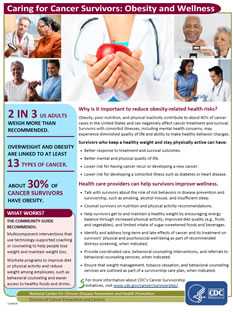Caring for Cancer Survivors: Obesity and Wellness
Fast Facts
- 2 in 3 U.S. adults weigh more than recommended.1
- Overweight and obesity are associated with at least 13 types of cancer.2 3
- About 30% of cancer survivors have obesity.4
For more information, visit Vital Signs: Obesity and Cancer.
Why is it important to reduce obesity-related health risks?
Obesity, poor nutrition, and physical inactivity contribute to about 40% of cancer cases in the United States and can negatively affect cancer treatment and survival.3 Survivors with comorbid illnesses, including mental health concerns, may experience diminished quality of life and ability to make healthy behavior changes.
Survivors who keep a healthy weight and stay physically active can have—
- Better response to treatment and survival outcomes.
- Better mental and physical quality of life.
- Lower risk for having cancer recur or developing a new cancer.
- Lower risk for developing a comorbid illness such as diabetes or heart disease.
What Works?
The Community Guide recommends:
Multicomponent interventions that use technology-supported coaching or counseling to help people lose weight and maintain weight loss.
Worksite programs to improve diet or physical activity and reduce weight among employees, such as behavioral counseling and easier access to healthy foods and drinks.
Health care providers can help survivors improve wellness.
- Talk with survivors about the role of risk behaviors in disease prevention and survivorship, such as smoking, alcohol misuse, and insufficient sleep.
- Counsel survivors on nutrition and physical activity recommendations.
- Help survivors get to and maintain a healthy weight by encouraging energy balance through increased physical activity, improved diet quality (such as fruits and vegetables), and limited intake of sugar-sweetened foods and beverages.5
- Identify and address long-term and late effects of cancer and its treatment on survivors’ physical and psychosocial well-being as part of recommended distress screening, when indicated.
- Provide coordinated care, behavioral counseling interventions, and referrals to behavioral counseling services, when indicated.
- Ensure that weight management, tobacco cessation, and behavioral counseling services are outlined as part of a survivorship care plan, when indicated.
References
1 National Center for Health Statistics. Prevalence of overweight, obesity, and extreme obesity among adults aged 20 and over: United States, 1960–1962 through 2013–2014. Health E-Stats. Hyattsville, MD. 2016.
2 Lauby-Secretan B, Scoccianti C, Loomis D, Grosse Y, Bianchini F, Straif K; International Agency for Research on Cancer Handbook Working Group. Body fatness and cancer—viewpoint of the IARC Working Group. New England Journal of Medicine 2016;375:794–798.
3 Steele BC, Thomas CC, Henley SJ, Massetti GM, Galuska DA, Agurs-Collins T, Puckett M, Richardson LC. Vital Signs: Trends in incidence of cancers related to overweight and obesity—United States, 2005–2014. MMWR 2017.
4 Shoemaker ML, White MC, Hawkins NA, Hayes NS. Prevalence of smoking and obesity among U.S. cancer survivors: estimates from the National Health Interview Survey, 2008–2012. Oncology Nursing Forum 2016;43(4):436–441.
5 International Agency for Research on Cancer. Energy balance and obesity IARC Working Group Reports 2017;10.
More Information
Related Research
- Depression and quality of life before and after breast cancer diagnosis in older women from the Women’s Health Initiative
- Psychological distress in long-term survivors of adult-onset cancer
- The essential role of public health in preventing disease, prolonging life, and promoting health of cancer survivors
- Current depression among adult cancer survivors
- Depression and anxiety in long-term cancer survivors compared with spouses and healthy controls
- Symptom burden and quality of life in survivorship
- Mental and physical health-related quality of life among U.S. cancer survivors
- Double jeopardy? Age, race, and HRQOL in older adults with cancer
- Disparities in HRQOL of cancer survivors and non-cancer managed care enrollees
- Income disparities in the quality of life of cancer survivors
- Rural-urban disparities in health status among U.S. cancer survivors
- Depression and cancer mortality
- Page last reviewed: October 17, 2017
- Page last updated: October 17, 2017
- Content source:
- Maintained By:


 ShareCompartir
ShareCompartir
